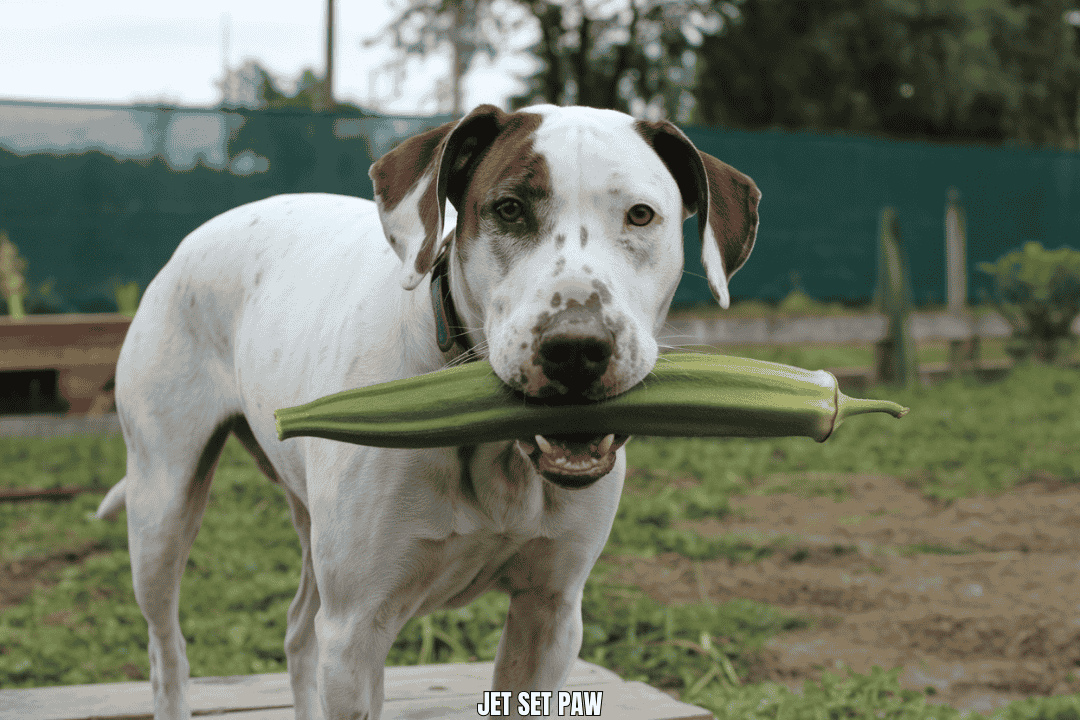Okra is a green vegetable popular in many parts of the world. It’s known for its unique texture and mild flavor. Okra pods are long and slender, with a slightly fuzzy exterior.
People often use okra in soups, stews, and stir-fries. Some folks even enjoy it fried or pickled. This veggie is packed with nutrients like fiber, vitamins, and minerals, making it a healthy choice for humans.
As pet owners, it’s crucial to understand what foods are safe for our furry friends. Dogs have different digestive systems than humans, and some foods that are harmless to us can be dangerous for them.
Knowing which foods are safe helps keep our dogs healthy and prevents accidental poisoning. It also allows us to share healthy treats with our pets and add variety to their diets.
By being informed about dog-safe foods, we can make better choices for our canine companions and avoid unnecessary trips to the vet.
Can Dogs Have Okra?
Yes, dogs can eat okra in moderation.
Good news for dog owners! Your furry friend can indeed enjoy okra as a treat. It’s safe for dogs to eat this green vegetable, but like many human foods, it should be given in moderation.
Okra can be a healthy snack for your dog when offered occasionally and in small amounts. Remember, while eating okra is okay for dogs, it shouldn’t replace their regular, balanced diet.
Rest assured, okra is not poisonous or toxic to dogs. Unlike other human foods, such as chocolate or grapes, okra doesn’t contain any substances harmful to canines.
This means you don’t need to panic if your dog sneaks a bite of okra from your plate or garden. However, just because it’s not toxic doesn’t mean dogs should eat large quantities of it.
As with any new food, it’s best to introduce okra slowly and in small amounts to avoid any digestive upset.
The Nutritional benefits of Okra for Dogs
1) Low in calories
Okra is a great low-calorie treat for dogs. This is excellent news if you’re watching your pup’s weight or if they need to shed a few pounds.
Okra contains few calories, so you can give your dog a tasty snack without worrying about them packing on extra pounds.
This makes it a healthier alternative to many store-bought dog treats, which are often high in calories and fats.
2) High in fiber
Okra is packed with fiber, which can be great for your dog’s digestive system. Fiber helps keep things moving smoothly in your dog’s gut, potentially preventing constipation and promoting regular bowel movements.
It can also help your dog feel full, which is helpful if they always beg for food. Just remember, too much fiber can cause stomach upset, so it’s vital to introduce okra slowly and in small amounts.
3) Rich in vitamins and minerals
This green veggie is a powerhouse of nutrients that can benefit your dog’s health. Okra contains vitamins like A, C, and K, which support your dog’s immune system, vision, and blood clotting.
It also has minerals such as potassium, which is good for heart health, and magnesium, which helps with muscle and nerve function.
While dogs should get most of their nutrients from their regular dog food, the extra boost from okra can be a nice addition to their diet.
Potential Risks of Feeding Okra to Dogs
a) Choking hazard
While okra can be a healthy dog treat, knowing the potential choking risk is essential. Whole okra pods can be tricky and stringy, which might be hard for some dogs to chew correctly.
This is especially true for small dogs or those who gulp food without chewing. To avoid this risk, cutting the okra into small, bite-sized pieces before giving it to your dog is best. This way, your pup can enjoy the treat safely without the danger of choking.
b) Digestive issues if overfed
Like many human foods, too much okra can upset your dog’s stomach. If you give your dog too much okra, they might experience digestive problems such as diarrhea, vomiting, or gas.
This is often because of the high fiber content in okra. While some fiber is suitable for dogs, a sudden increase can be hard on their digestive system.
To avoid these issues, give your dog only a small amount of okra and watch for any adverse reactions. Always introduce new foods slowly and in moderation.
c) Possible allergic reactions
Although it’s rare, some dogs might be allergic to okra. Signs of an allergic reaction can include itching, swelling, difficulty breathing, or upset stomach.
If you notice any of these symptoms after giving your dog okra, stop feeding it to them right away and contact your vet.
It’s always a good idea to watch your dog closely when introducing new food to their diet, including okra. If you’re worried about allergies, you can ask your vet to test your dog before trying new foods.
How to Safely Feed Okra to Your Dog
When feeding okra to your dog, proper preparation is key. Start by washing the okra thoroughly to remove any dirt or pesticides.
It’s best to serve okra to your dog raw or lightly cooked without any seasoning. Avoid using oils, spices, or salt, as these can harm dogs.
Cut the okra into small, bite-sized pieces to prevent choking, especially for smaller dogs. If you cook the okra, steaming or boiling are good options, but ensure it’s cooled down before serving.
The amount of okra you give your dog depends on their size and overall diet. Generally, treats, including vegetables like okra, should make up no more than 10% of your dog’s daily calorie intake.
Start with just one or two small pieces of okra for a medium-sized dog and see how they react. If they tolerate it well, you can gradually increase the amount, but always in moderation.
As for how often you can feed okra to your dog, it’s best to think of it as an occasional treat rather than a regular part of their diet.
Once or twice a week is plenty for most dogs. Remember, your dog’s central nutrition should come from their regular dog food.
Okra and other vegetables should be seen as a supplement to their diet, not a replacement for balanced dog food.
Always keep an eye on your dog after introducing any new food, and consult with your vet if you have any concerns about adding okra to your dog’s diet.
Other Vegetables Safe for Dogs
Many vegetables are safe and healthy for dogs to eat. Here’s a list of some dog-friendly veggies:
- Carrots
- Green beans
- Sweet potatoes
- Pumpkin
- Broccoli
- Cucumber
- Spinach
- Peas
- Celery
- Bell peppers
These vegetables can be a great way to add variety to your dog’s diet and provide extra nutrients. Remember to introduce any new food slowly and in small amounts.
While okra is a good vegetable choice for dogs, some of these other options might have different benefits or drawbacks:
Carrots, like okra, are low in calories and high in fiber. Their crunchy texture is also great for dental health. Sweet potatoes are higher in calories than okra but are packed with vitamins and can be good for digestive health.
Green beans are similar to okra in being low-calorie and high-fiber. They’re often recommended for dogs on a diet. Pumpkin is excellent for digestive issues and can help with diarrhea and constipation.
Broccoli is nutrient-rich like okra but should be given in smaller amounts as too much can cause gas. Cucumber is very low in calories and water content, making it a good choice for overweight dogs.
Overall, while okra is a healthy option, these other vegetables can offer a range of benefits and can be rotated in your dog’s diet for variety. As with okra, always prepare these vegetables properly and feed them in moderation.
When to Avoid Giving Okra to Your Dog
1) Health conditions that may interfere
While okra is generally safe for most dogs, there are some health conditions where you should avoid giving it to your pet.
If your dog has kidney problems, the high oxalate content in okra could be an issue. Oxalates can contribute to kidney stone formation in dogs prone to this condition. Dogs with sensitive stomachs or digestive issues might also have trouble with okra’s high fiber content.
If your dog is overweight or diabetic, you should be careful with any treats, including okra, and always check with your vet first.
2) Signs of allergic reactions to watch for
Although allergic reactions to okra in dogs are rare, it’s essential to know what to look for, just in case. After feeding your dog okra for the first time, watch for these signs:
- Itching or scratching more than usual
- Swelling of the face, lips, or tongue
- Hives or rashes on the skin
- Vomiting or diarrhea
- Difficulty breathing
- Excessive drooling
- Sudden changes in behavior or energy levels
If you notice any of these signs after giving your dog okra, stop feeding it to them right away and contact your vet. It’s always better to be safe and get professional advice if you’re worried about a possible allergic reaction.
Remember, every dog is different, and what’s safe for one might not be for another. Always introduce new foods slowly and in small amounts to watch for adverse reactions.
Conclusion
Okra can be a healthy and safe treat for most dogs when appropriately given. Remember to wash and prepare okra carefully, cutting it into small pieces to prevent choking.
Feed it to your dog in moderation, with just a few pieces at a time. Okra should only be an occasional treat, not a main part of your dog’s diet.
There are many other safe vegetables you can give your dog, too, like carrots, green beans, and sweet potatoes. Each has its benefits and can add variety to your dog’s treats.
While this guide provides general information, talking to your vet before making significant changes to your dog’s diet is crucial.
Every dog is unique, and what works for one might not work for another. Your vet knows your dog’s health history and can give personalized advice.
They can help you decide if okra is a good choice for your dog and how much to give. Your vet’s input is even more critical if your dog has health issues or allergies.
They can also guide you on introducing new foods safely and what signs to watch for if something doesn’t agree with your dog. Always work closely with your veterinarian to prioritize your dog’s health and safety.

